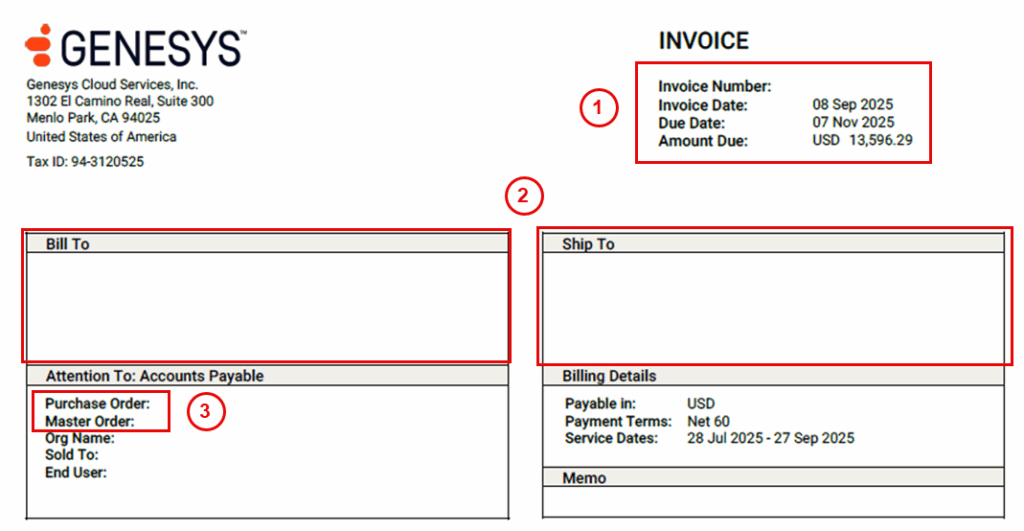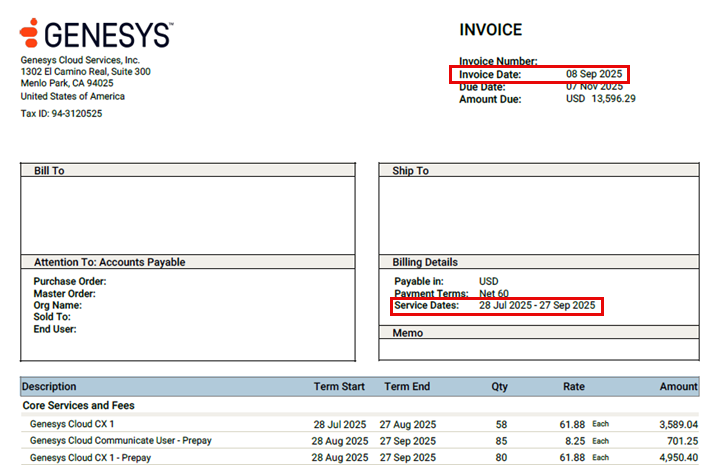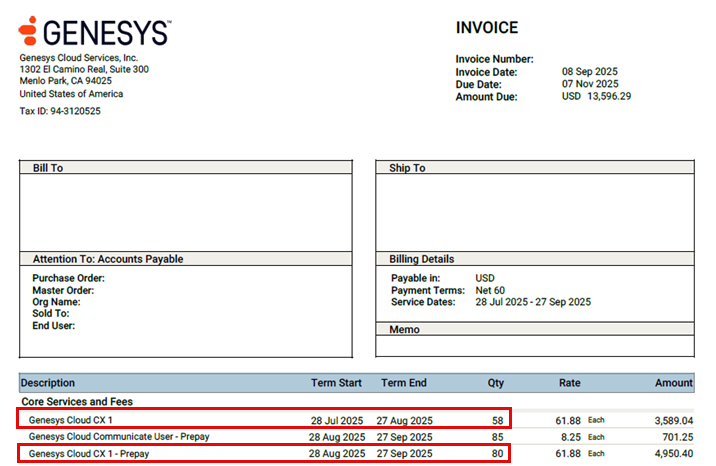Your Genesys Cloud invoice—the basics
This guide walks you through the key elements of your Genesys Cloud invoice, including how to:
- Understand the invoice.
- Interpret service dates.
- Distinguish between prepay and on-demand charges.
- Identify resource usage, telco charges, and taxes and fees.
Invoice header
Every invoice begins with the header details. You accounting team uses these core identifiers: Invoice Number, Invoice Date, Due Date, and Amount Due. The invoice also displays the Bill To, Ship To, and references to the Purchase Order and Master Order.
- The Bill To can be a reseller when you purchased through a partner.
- The Ship To address shows the end customer.
- The Purchase Order number helps your AP team tie the invoice back to your internal systems.
Service dates
The service dates show the exact period of service or usage being billed. These dates do not always match the invoice date.
- Invoice Date: The date that the bill was issued.
- Service Dates: The date that the service was delivered or consumed, and typically represent:
- Usage in arrears (for the month just ended).
- Prepay in advance (the upcoming month’s committed licenses for an annual month-to-month billing term, or the upcoming year’s committed licenses for an annual prepay billing term).
Invoices can sometimes span multiple months when they include both usage and prepay. For example, the example invoice was issued on September 8, and has a service period of two months (July 28 through September 27). This service period includes both prepay and on-demand line items.
Servicios básicos y tasas
In the Core Services and Fees section, two different types of line items for subscription licenses, prepay and on-demand, appear. Also, the invoice shows resource charges for usage of other resources that exceed your Genesys Cloud fair use policy allowance.
Subscription licenses (prepay and on-demand)
Prepay
The invoice reflects the number of licenses that you commit to in your Service Order (contract). They are billed at a discounted rate and always align to your contract quantities. Prepay items show forward-looking dates, one month, or one year ahead of the service period, depending on your billing term, because you pay in advance for that commitment.
On-Demand (Usage)
If you did not sign a monthly or annual prepay subscription, or you use more licenses than you commit to as part of those subscriptions, then charges on your invoice appear as on-demand. Genesys bills these licenses at the on-demand rate, and shows dates that match the actual service period on your invoice. Genesys bills on-demand overage charges for both month-to-month prepay and annual prepay subscriptions monthly in arrears.
This distinction helps you quickly see which charges are tied to your contract as compared with extra usage and also explains why your invoice can show two different month ranges in the Service Dates section.
For more information about how to find more granular usage detail, see View your billing and usage summary. This level of detail can be beneficial if you want more detailed billing reconciliation.
Resource usage (Core Services and Fees)
Examples of resources that are metered and billed in arrears, when they exceed your fair use allowance, include:
- API calls above allowance
- Data storage overages
- IVR minutes over allowance
- BYOC (Bring Your Own Carrier) usage beyond the included minutes
These charges appear as extra line items, separate from your contracted Prepay or On-Demand user lines. The charges only appear if your actual usage exceeds the Genesys Cloud fair use policy allowances that are included with your licenses.
For more information about how to calculate your resource usage for common resources, see Understand BYOC Cloud billing on your invoice and Understand resource usage on your invoice.
Cargos por uso de telecomunicaciones
The Telco Usage Charges section is always separate and only covers telephony-related usage. Examples include:
- Inbound and outbound calling
- Números gratuitos
- Llamadas internacionales
- SMS or other third-party messaging
Unlike resource usage, Telco charges are always usage-based and appear each month, depending on your activity. For more information about telco charges, see Reconcile your Genesys Cloud Voice invoice against your usage report.
Taxes, fees, and other
The Taxes, Fees, and Other section shows charges that government authorities, not Genesys, mandate. These charges can include:
- Regulatory Recovery Fees
- Federal Universal Service Fund (USF)
- 911 fees
- State and local surcharges or excise taxes
These charges exist because Genesys must collect and remit them.
Remittance and support info
At the bottom of every invoice, information for payment or where to ask questions appears. This information includes:
- Payment mailing address
- Bank account details
- Billing contact email addresses
- Helpful links to reconcile usage and review Fair Use policies
Remittance and support information ensures that you know exactly where to send payment and where to go for help for clarification.
Principales conclusiones
- Invoice Header: Identifies your invoice and ties it to your orders.
- Service Dates: Dates can differ from Invoice Date, and can span multiple months when both prepay and usage are included.
- Prepay vs. On-Demand: Prepay equals contract commitment (forward-looking dates); On-Demand equals actual usage (past dates).
- Resource Usage: If you exceed fair use, then extra charges (API, storage, IVR, BYOC) appear under Core Services.
- Telco Charges: Telephony-specific usage always appears in its own section.
- Taxes and Fees: Mandated government fees that Genesys applies, unless exemption documentation is current.
- Remittance: Check payment instructions and support contacts at the bottom of your invoice.
¿Aún tienes preguntas?
La parte inferior de su factura incluye enlaces a la Política de uso razonable de Genesys y a los recursos de facturación de Genesys Cloud. Estos artículos explican detalladamente cómo se calculan las dietas y los excesos para que pueda verificar sus gastos en cualquier momento.
También puede ponerse en contacto con el equipo de facturación de Genesys en ask.finance@genesys.com.








